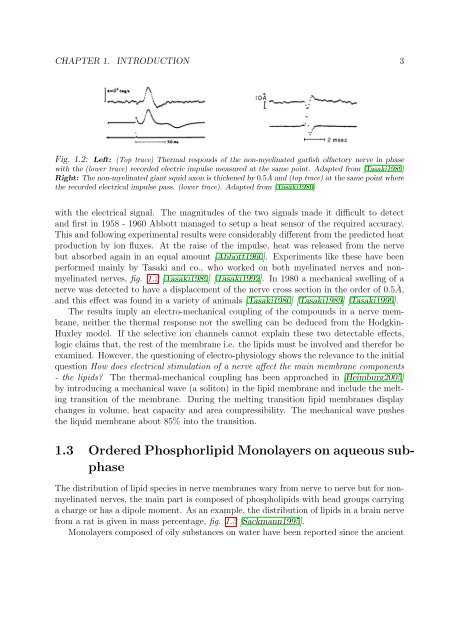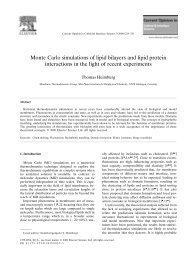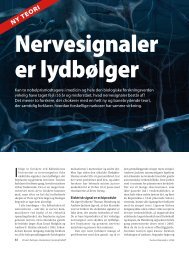Electric Gradient Field Applied to Lipid Monolayers - Membrane
Electric Gradient Field Applied to Lipid Monolayers - Membrane
Electric Gradient Field Applied to Lipid Monolayers - Membrane
You also want an ePaper? Increase the reach of your titles
YUMPU automatically turns print PDFs into web optimized ePapers that Google loves.
CHAPTER 1. INTRODUCTION 3<br />
Fig. 1.2: Left: (Top trace) Thermal responds of the non-myelinated garfish olfac<strong>to</strong>ry nerve in phase<br />
with the (lower trace) recorded electric impulse measured at the same point. Adapted from [Tasaki1989]<br />
Right: The non-myelinated giant squid axon is thickened by 0.5Å and (<strong>to</strong>p trace) at the same point where<br />
the recorded electrical impulse pass. (lower trace). Adapted from [Tasaki1980]<br />
with the electrical signal. The magnitudes of the two signals made it difficult <strong>to</strong> detect<br />
and first in 1958 - 1960 Abbott managed <strong>to</strong> setup a heat sensor of the required accuracy.<br />
This and following experimental results were considerably different from the predicted heat<br />
production by ion fluxes. At the raise of the impulse, heat was released from the nerve<br />
but absorbed again in an equal amount [Abbott1960]. Experiments like these have been<br />
performed mainly by Tasaki and co., who worked on both myelinated nerves and nonmyelinated<br />
nerves, fig. 1.2 [Tasaki1989] [Tasaki1992]. In 1980 a mechanical swelling of a<br />
nerve was detected <strong>to</strong> have a displacement of the nerve cross section in the order of 0.5Å,<br />
and this effect was found in a variety of animals [Tasaki1980] [Tasaki1989] [Tasaki1999].<br />
The results imply an electro-mechanical coupling of the compounds in a nerve membrane,<br />
neither the thermal response nor the swelling can be deduced from the Hodgkin-<br />
Huxley model. If the selective ion channels cannot explain these two detectable effects,<br />
logic claims that, the rest of the membrane i.e. the lipids must be involved and therefor be<br />
examined. However, the questioning of electro-physiology shows the relevance <strong>to</strong> the initial<br />
question How does electrical stimulation of a nerve affect the main membrane components<br />
- the lipids The thermal-mechanical coupling has been approached in [Heimburg2005]<br />
by introducing a mechanical wave (a soli<strong>to</strong>n) in the lipid membrane and include the melting<br />
transition of the membrane. During the melting transition lipid membranes display<br />
changes in volume, heat capacity and area compressibility. The mechanical wave pushes<br />
the liquid membrane about 85% in<strong>to</strong> the transition.<br />
1.3 Ordered Phosphorlipid <strong>Monolayers</strong> on aqueous subphase<br />
The distribution of lipid species in nerve membranes wary from nerve <strong>to</strong> nerve but for nonmyelinated<br />
nerves, the main part is composed of phospholipids with head groups carrying<br />
a charge or has a dipole moment. As an example, the distribution of lipids in a brain nerve<br />
from a rat is given in mass percentage, fig. 1.3 [Sackmann1995].<br />
<strong>Monolayers</strong> composed of oily substances on water have been reported since the ancient







